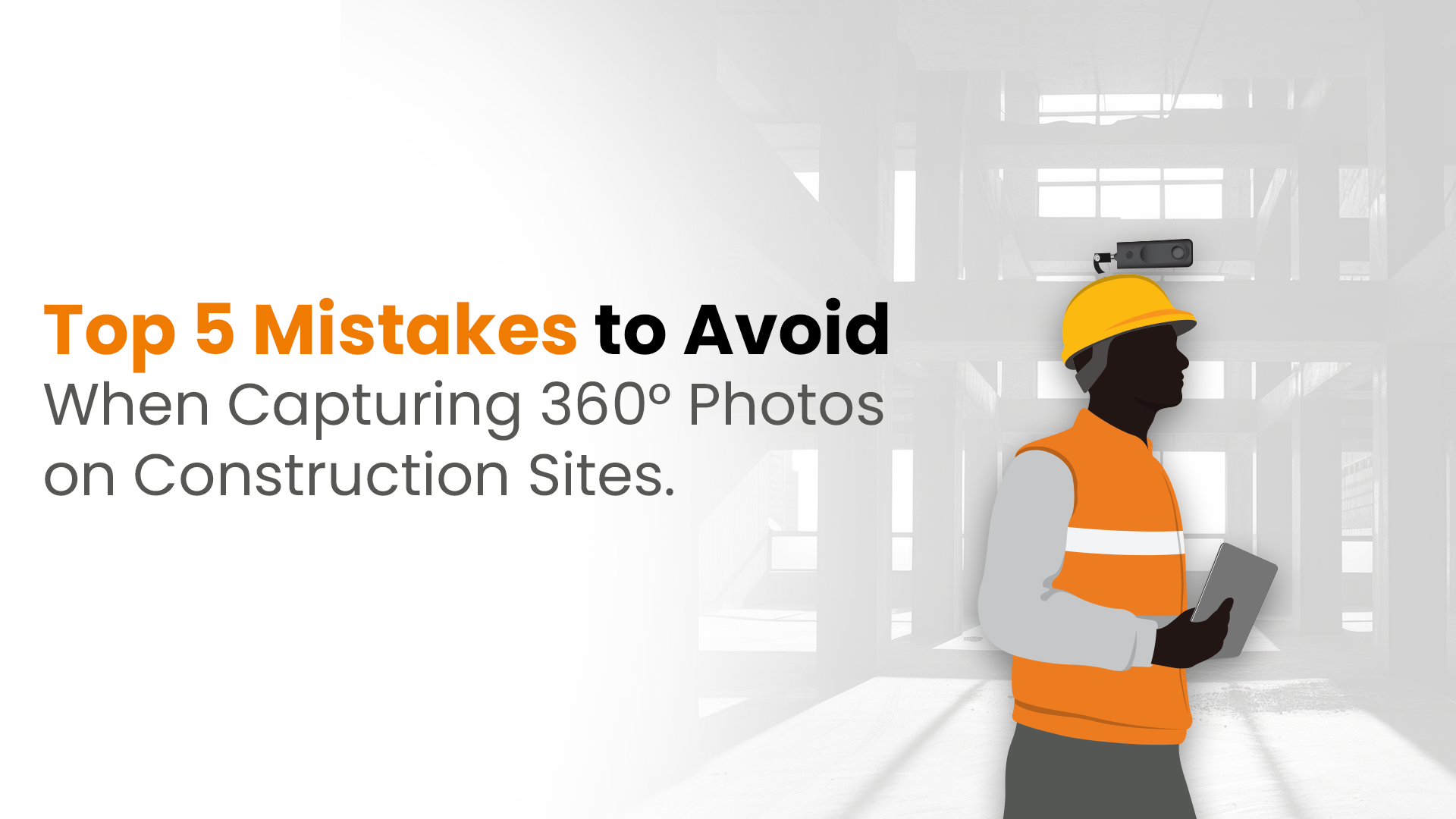Introduction.
The construction sector has undergone a significant transformation with 3600 photo documentation which includes site tracking and helps stakeholders with virtual walkthroughs and progress verification. Immersive visualization refines Lean workflows, improves communication, and helps with As-Built documentation. However, documenting efficient and reliable 360-degree photos on the job site requires more than a simple setting of cameras. Errors done during the image capture process can degrade the reliability of construction documentation and restrict its value for downstream functions including progress monitoring, management of claims, trade coordination, and creation of digital twins.
The following article explores the top 5 mistakes that need to be prevented when documenting 3600 photos of the job site, along with the need to enable best practices for enhancing the quality of the image, achieving consistency, and extending usability.
Top 5 mistakes to prevent with 360-degree photo documentation.
Inaccurate placement of cameras or other photo capture equipment.
Why is it important?
Positioning the 3600 camera in a relative setting to surrounding spaces impacts the field of view, depth visualization, and spatial alignment of captured photos. Placing cameras in an improper location leads to an inconsistent perspective, occluded-ridden views, and inaccurate documentation.
What are the common errors that are observed?
- Putting the camera very close to building elements like doors, walls, equipment, etc. can mask visibility.
- Mounting the 360-degree camera lower or higher, skews the perspective at the eye level.
- Placement inconsistencies between capture sessions make it challenging to enable comparisons.
Best practices that need to be enabled.
- Place the 360-degree camera at a suitable height to achieve a consistent eye level.
- Keep the camera in spaces including pathways that are open or room centers for greater visualization.
- Regularize the position of the camera using site markers or tripod markers to realize precise evaluations.
Lighting conditions that are not incoherent.
Why is it important?
As 3600 cameras take in light simultaneously from various directions, poor light conditions lead to details that are blurry, cause color issues, and image graining that makes it challenging to assess the condition of the job site.
What are the common errors that are observed?
- Taking 360-degree photos in conditions that are driven by low light or are extremely bright without utilizing compensatory strategies.
- Not taking into consideration glares or shadows from lighting setups that are temporary.
- Unable to compute fluctuating daylight conditions – photo captures during midday or dusk.
Best practices that need to be enabled.
- Employ HDR-based 3600 cameras to strike a balance between areas that are bright and dark.
- Prepare a schedule when lighting conditions are consistent – timing during mid-morning.
- Use lighting systems that are mobile if there is no source of permanent lighting.
Inconsistencies within capture timings and range.
Why is it important?
3600 photo documentation shows higher consistency when it follows a set flow and detailed spatial coverage. Irregularities within photo capture intervals or left-out spaces cause gaps in documentation and lead to lower reliability in achieving visual records.
What are the common errors that are observed?
- Selective 360-photo capture of zones and rooms of the complete job site.
- Fluctuating angles and routes between sessions.
- Inconsistencies in photo documentation – too frequent or delayed leads to wasted time and missed milestones.
Best practices that need to be enabled.
- Define a precise documentation schedule that aligns with required milestones.
- Set defined walking paths or embed QR code markers to achieve complete documentation coverage.
- Utilize floor plans with camera positions that are marked to regularize every capture session.
Not taking into consideration photo resolution and consistent file management.
Why is it important?
360-degree photos that are taken in low-resolution impede the ability for stakeholders to zoom into crucial details including piping, wiring, or finishes. Furthermore, file management that is unstructured makes it challenging to get back past data that is needed for RFIs, disputes, or job site inspections.
What are the common errors that are observed?
- Placing the settings of the camera to default or very low resolution saves space or reduces upload time.
- Inability to organize photos with metadata that embeds phase, location, and time.
- Absence of file backups or reinforcing them within project management tools.
Best practices that need to be enabled.
- Take pictures at high resolution preferably – 5.5k+.
- Use tools that can auto-tag photos with timestamps, GPS, and location or rooms.
- Store photos within well-structured folders or platforms like Lens360, Holobuilder, etc. for quick access and assessment.
Inability to provide proper training for operators or absence of regularized workflows.
Why is it important?
Documenting site photos is the job of quality inspectors and site engineers. In the absence of required SOPs or training, the pipeline shows errors and inconsistencies.
What are the common errors that are observed?
- Giving these tasks or assignments to personnel who are not trained.
- Failing to verify the quality of the photos after capturing them.
- Absence of a checklist to enable reviews and uploads.
Best practices that need to be enabled.
- Provide training for personnel on equipment setup, use of mobile apps, and documentation guidelines.
- Deploy a robust quality check pipeline after every capture session.
- Build refined SOPs to capture and sync images on a centralized platform.
Heading to a conclusion.
360-degree photo documentation is an advanced and powerful tool, but it requires the support of best practices to be deployed effectively and efficiently. It provides auditable value to monitor progress, achieve QA, mitigate risks, and build digital twins. However, the smallest mistake which includes inaccurate camera placement, inconsistencies in scheduling, or even uneven lighting creates catastrophic results that can impede the use and quality of the 360-degree photos.
Construction teams who want to use 3600 photos need to deploy strong workflows, invest in resource training, and enable the use of integrated tools to achieve analysis and documentation. By preventing the above-mentioned mistakes, stakeholders can build a valid record of job site conditions, improve remote collaboration, and create a robust archive of project history.
A quick tip: Use customized platforms like iFieldSmart Technologies or Lens360 to overlap photos on floor plans, create time-lapse views, and integrate 3D BIM models or construction management platforms – add value for the next project with visual data that creates an impact.

